#Germaine de foix
Explore tagged Tumblr posts
Text
My thoughts on this painting
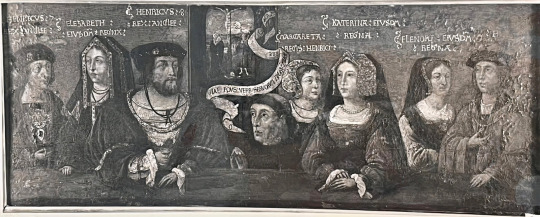
I found it on twitter account called Tudor Extra, and they say it has been recently discovered by Dr Emma Cahill Marrón(on twitter as EmmaLCahill) in London.(link is at end of post)
Honestly in closeup it looks in really poor state.
On left are obviously Henry's parents and correctly identified so.
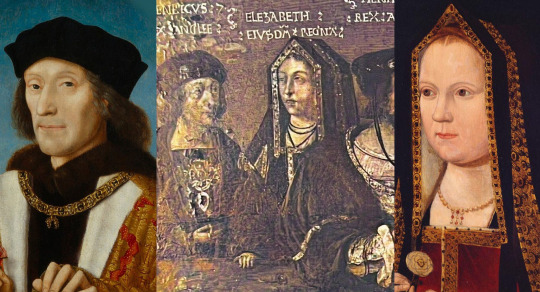
But i am not so sure about rest of figures being correctly identified. Or rather I am sure they aren't!
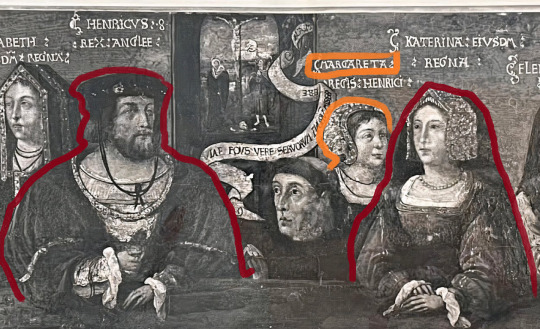
Yes, the figures lined in red are Henry VIII and Catherine of Aragon.
But the orange I lined in orange is supposed to be Margaret Tudor. Henry VIII's sister. Fashion-wise it's possible.
Catherine's gable hood has both veils down, frontlets up. So at earliest it could be somewhere in 2nd half of 1510s, at latest late 1520s. The lack of ends of paste would point to c.1520(however if this was a copy...painters tend to not include them, or not give them justice...) So I am not 100% trusting it.
Margaret left England in 1517(read up on her life, if you want to know more), so in theory she could have been included here. But why is she by Catherine's side? Or rather behind that. Odd isn't it?
Such possition would much better fit Mary I. The sizes can be deceiving here...because in reality Catherine is supposed to be way smaller than Henry...
Hence this figure doesn't necessarily have to be a child(Mary I), but could be. And Mary was wearing same cap in Vyne chapel(where is commonly mistaken for her mother.)
(If there was Margaret, why wouldn't there also be Mary Rose? (Henry's other sister). ...Wouldn't that be even more odd than his daughter being included.)
But...I am really buffled by two figures entirely on right side.
Allegedly on left is Eleanor of Austria and on right her husband Manuel I of Portugal, whom she married in 1518:

...Nobody thinks it weird? ...Just me?
Well, in my opinion. They are misidentified. Both of them.
The man wears order of golden fleece-but that wasn't limited to just Habsburgs, plenty of foreign royalty were honourary members. Including Manuel of Portugal and Ferdinand II of Aragon.
One would be normally considering if the entire portrait is not done to commemorate Charles V visit to England...with figure beside him being widowed Germaine of Foix(who was there!).
But why would Henry's parents be included in such portrait?...Makes no sense!
Unless...we're looking at dynastic portrait!!!
...Where Henry's parents are on left, Henry, Catherine and their daughter Mary in middle, and Catherine's parents on right!
This could certainly be Ferdinand:
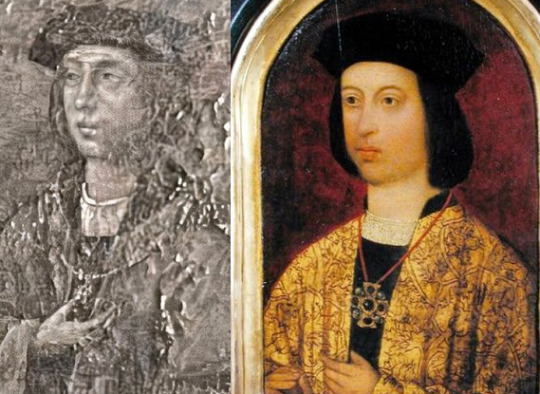
Ferdinand died in 1516, but Henry's parents were long dead too...
But...what about the woman? You cannot tell firmly the shape of gown and jewelry(mind could easily play tricks upon you.)

But why would Isabella wear french hood?
...And i considered that perhaps somebody confused portrait of Germaine of Foix or even real Eleanor and Joanna(netherlandish type of frenhc hood) with Isabella...
But then I noticed shape within the french hood's veil...
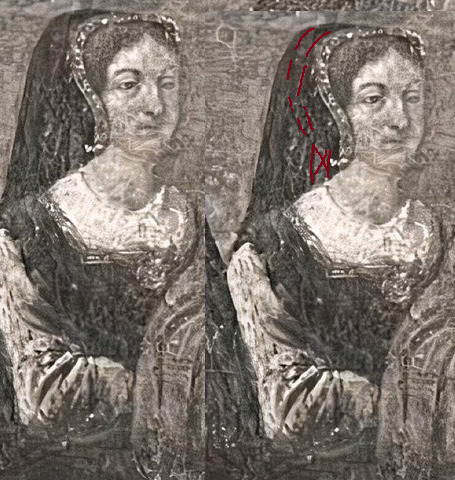
And it looks suspiciously like cofia de tranzado... the cap and 'braid', just where they are supposed to be.The headwear is overpainted!
Hence it could be based upon some portrait of Queen Isabella!
Unfortunately this is just card/print from Ancaster Collection, Grimstorpe castle labelled slightly wrong as family of Henry VII(instead of Henry VIII):
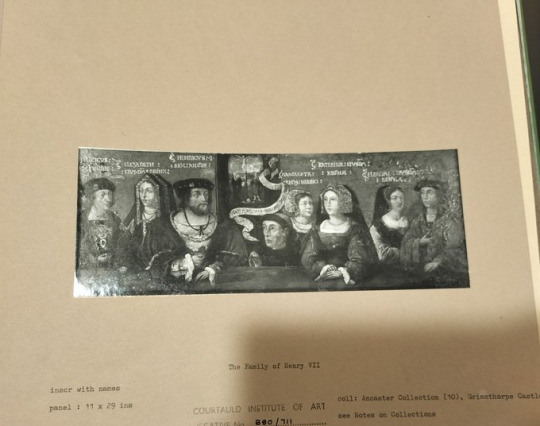
I hope we can all agree. It deserves way more love and attention.
This might be the first Tudor dynastic portrait!
Equivalent of Whitehall Mural or The family portrait from 1542/3.
...And if there is black and white card of it...is it drawing, engraving, printm or photograph? ...It could be out there...
PS: In it...Elizabeth of York is taller than Henry VII. Not that I'd trust the proportions entirely...but it'd be funny if true.
#historical portraits#tudor history#catherine of aragon#mary i of england#henry vii of england#elizabeth of york#mistaken identity
33 notes
·
View notes
Text
Thread about Joanna of Castile: Part 6.1: The Princes’ Journey : Juana of Castile and Philip of Burgundy Visit the French Court, 1501
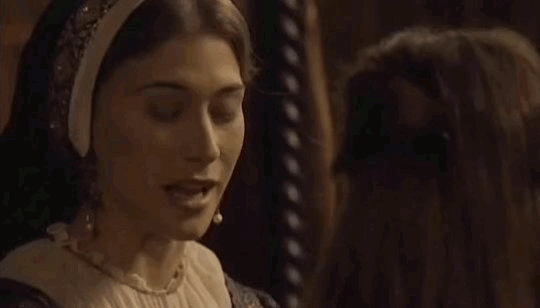
She finally made her way to Queen Anne who was sitting on her throne in front of the fireplace with the princess of Orange. Anne and Juana curtseyed and kissed and made some small talk. Shortly thereafter, the small talk faded. Juana then extended her salutations to the women on either side of the throne, including those from Angoulême, Alençon, and Dunois, as well as the niece of King Louis, Germaine de Foix. Four years after this visit, Germaine would marry Juana's widowed father, King Ferdinand.
The rest of the Queen's ladies were standing along the wall, but the Duchess of Bourbon grabbed Juana by the arm and told her it would take forever to greet and kiss all these ladies. She took Juana to her apartment. When she entered her antechamber she was met by Louis and Anne's daughter, Claude, who was two years old, in the arms of her governess' daughter. Madame de Tournon, the governess, stood behind a group of noblewomen and a group of little girls who were on their best behaviour. Claude took one look at Juana and burst into tears. She was taken away screaming at the top of her lungs.

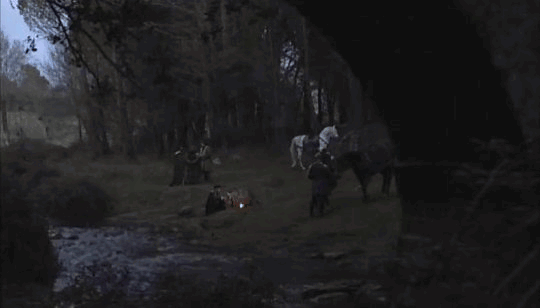
That evening Philip was wined and dined in considerable style. The king was observing the vigil of the Immaculate Conception so he fasted on bread and water and retired early. Juana was waited on by a deputation at seven o’clock with light refreshments. The king’s officer was followed by six pages dressed in the king’s red and yellow livery, each holding a candlestick in their hand. The Duchess of Bourbon followed carrying the preserves and Madame d’Angoulême carried the napkins. Madame de Nevers carried in the knives and forks followed by Charlotte d’Albret and Germaine de Foix, each carrying a dish of sugared almonds. The queen’s apothecary came in last in case Juana had any indigestion from the meal. Only ladies were allowed in the room and they left what they brought on a dresser and the beds.
Juana sat on a cushion on the floor with the Duchess of Bourbon who tried to put her at ease. The duchess rose at the end of the evening and diplomatically declared to Madame de Vendôme she was keeping Juana up and she needed her rest. She left Juana with Madame de Vendôme to show her the rest of her apartments and encouraged Juana to let her know if there was anything else she needed. To ensure there was to be nothing else needed, a procession of servants were furnishing Juana’s inner chamber with the best towels, bed-warmers, sponges, mirrors, nightcaps and pins. Even the basin of her close-stool was made of silver with gold plate around the rim.
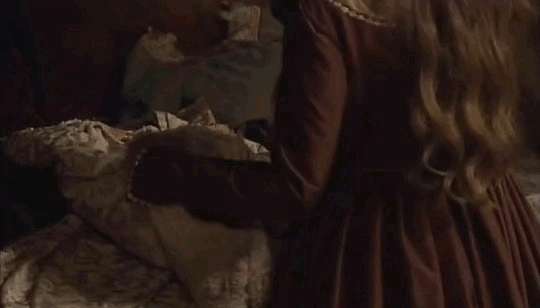
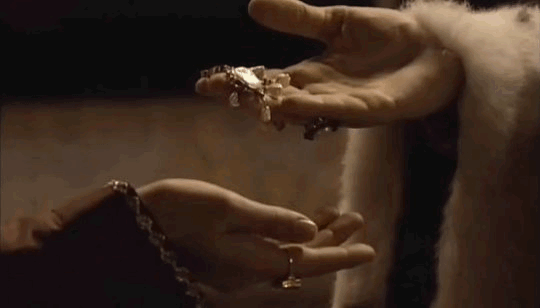
The next day, Queen Anne sent a purse of money for Juana to present in Anne’s name at mass. Juana refused to perform this act of vassalage and insisted she would only give money in her own name.
Anne waited for Juana to follow her out of the chapel but Juana lingered long enough to demonstrate she left on her own accord. Queen Anne was fuming and that evening Juana made her excuses saying she was ill to avoid the festivities. Several ladies of the French court carried spices to Juana.
Philip offered money in Louis’ name at mass that same day.
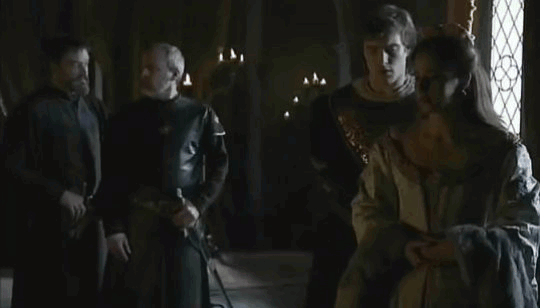
A few days later Juana appeared at dinner in Spanish style dress covered in jewels and cloth of gold. After supper she danced in the Spanish manner, impressing all with her elegance.
The entire visit was filled with banquets, dancing and many private suppers along with worship and thanksgiving. Unfortunately the dreadful weather made hunting impossible. The archducal couple would leave Blois on December 15 with King Louis accompanying them as far as Amboise. Madame d’Angoulême would entertain Juana and Philip for six days at her home in Cognac.

Louis was so pleased with the visit he dreamed of a peace treaty with Spain and Queen Anne’s hopes for the Habsburg marriage for her daughter were greatly increased.
Unfortunately, neither of these things happened. In April 1505, King Louis was gravely ill and the doctor’s feared for his life. He was forced to make a definitive decision regarding the marriage of his daughter Claude. In May 1506 he proclaimed in his will that six-year-old Claude would marry the eleven-year-old heir to the throne, Francois d’Angouleme. Claude eventually married Francois, who became King Francois I upon the death of Louis XII on January 1, 1515.
Sources : Further reading: “The Valois: Kings of France 1328-1589” by Robert Knecht,
“Juana the Mad: Sovereignty & Dynasty in Renaissance Europe��� by Bethany Aram
#joanna of castile#juana i of castile#philip the handsome#juana la loca#spanish monarchy#isabel#johanna van castilie#european history#history#irene escolar
8 notes
·
View notes
Note
What are your thougts on the studies that claim that Charles V's illegitimate daughter by his step-grandmother Germaine de Foix, the daiughter that was named Isabel, was in fact the same person as the other, more famous royal bastard Margarita de Parma? (not 2 royal bastards but 1)
I haven't read studies focused on Charles and haven't heard this claim. But I'm currently reading Geoffrey Parker's Spanish biography of Philip II and Parker says that Charles didn't have a child with Germaine de Fox, that Manuel Fernández Álvarez (Spanish historian and another biographer of Charles) was wrong in claiming that he had and Parker cites Vicente de Cadenas y Vicent who I understand was a Spanish genealogist. I think Parker may elaborate more on this and on Charles's relationship with Germaine in his biography of Charles (and I suggest you to check it if you haven't done it already) but I think it certainly leads to question that popular story of Charles having a child with his "grandmother" and it may well turn out to be a myth.
Parker as Charles's known illegitimate children lists Margaret of Parma, Tadea della Penna de Perugia (both born in 1522), one Juana (born in 1523) and Don Juan of Austria (born in 1547).
4 notes
·
View notes
Note
Omg I just learned about Germaine of foix. & I’m shooketh I’m a history lover of queens & kings I cannot believe I missed this 😭
Germaine was definitely one of the most interesting figures in Spanish history at that time, where there are so many interesting figures.
5 notes
·
View notes
Text


Signs, seals and signatures of queens in the Crown of Aragon:
GERMAINE DE FOIX (1488? -1536)
We keep a seal and her signature. The seal has a shield crowned with the arms of Castile, Leon, Granada, Aragon, Sicily, Jerusalem, Foix, Bearn, Navarre, Evreux and Bigorre.
32 notes
·
View notes
Photo


“You are worthy grandson of your grandfather Ferdinand.”
In 1518 Germaine gave birth to a daughter. (...) From the birth of the little girl, as if both were aware of having gone too far, the romantic relationship between Charles and Germaine ended. In 1519, perhaps to silence the slanderes, Charles give Germaine de Foix in marriage to Marquis of Brandenburg and assigned them the city of Valencia, granting her the position of vice-queen and lieutenant of the Levantine kingdom. - María Pilar Queralt del Hierro, Reinas en la sombra.
#Charles V#germaine de foix#carlos rey emperador#carlosreyedit#perioddramaedit#historyedit#fyeahperioddrama#mine.#mine: history#charles i of spain#house of habsburg#Spanish History#mine#history#I still trying better my english so sorry for anything mistake
158 notes
·
View notes
Text
Baroness Michelle de Soubise, Anne of Brittany’s Dame d’atour ~ A guest post by Keira Morgan
Baroness Michelle de Soubise, Anne of Brittany’s Dame d’atour ~ A guest post by Keira Morgan

Coat of Arms of Parthenay , Gimel-les-Cascades , and the Parthenay-l’Archevêque house
Keira is a writer of historical fiction based on the lives of French Renaissance Women. She joins us today with a post about Anne of Brittany’s Dame d’atour. You can find her work at http://keiramorgan.com
The office of Dame d’atourwas among the highest-ranked offices among the queen of France’s…
View On WordPress
#Anne de Candale#Anne of Brittany#Baroness Michelle de Soubise#Claude#Duchess of Angoulême#Duke Hercule d’Este of Ferrara#Ferdinand of Aragon#Francis I#French history#Germaine de Foix#King of Aragon#King of France#Louis XII#Louise of Savoy#Princess Renée#Queen of Aragon#Queen of France#Queen of Hungary#Renaissance history
0 notes
Photo
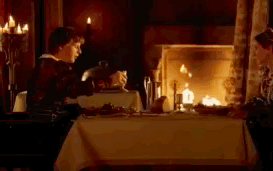
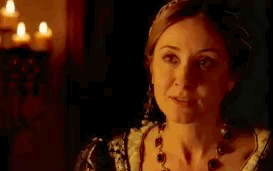
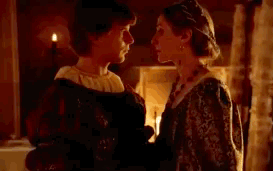
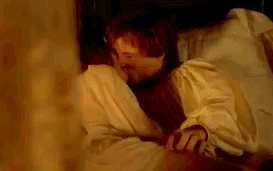
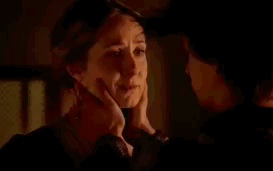
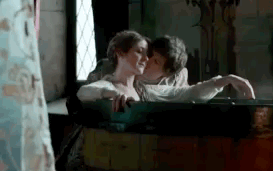
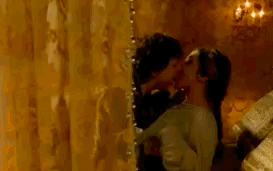

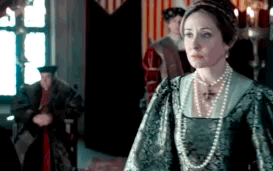
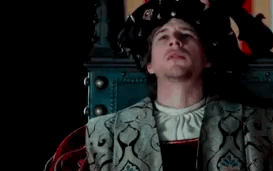
Charles V & Germaine de Foix
Years ago, historian from Valencia, Regina Pinilla Pérez de Tudela, during her research for doctoral thesis about Germaine de Foix, found documents, that would indicate Germaine and her step-grandson, Charles V, had a love affair.
Germaine was the second wife of Ferdinand II of Aragon, who married her in order to double cross his son-in-law, Philip the Handsome, allying himself with his natural enemy, Louis XII of France, and to get a male heir, given the salic law in his kingdom, according to which, the crown would go straight into Philip’s hands after Ferdinand’s death.
At the time Germaine was 17 and Ferdinand 53 years old. In May of 1509 Germaine gave birth to Ferdinand’s son, John, who died shortly afterwards. They did not have more children.
In 1515 the Venetian ambassador Zuan Badoer said that:
The Queen his wife, a French woman, the sister of Monseigneur de Fois, is very fat, and she will not bear children.
Ferdinand, exhausted by severe illness and his long, and turbulent reign, died on 23th January of 1516. In the instructions directed at his grandson, Charles, the king asked him to take care of his young widow:
…after God there is nothing more left to her but you…
In 1516 Germaine did not have anyone of her closest family, who could take care of her. She became an orphan before her marriage to king Ferdinand, her brother Gaston de Foix, died in the battle of Ravenna in 1512, and her uncle, Louis XII of France, passed away in 1515. Although she was a claimant to the throne of Navarre, it was conquered by Ferdinand in 1512 and annexed to the Crown of Castile three years later, making his daughter, Joanna I of Castile, its nominal Queen. Germaine was left alone in foreign and hostile country.
Charles came to Spain in 1517 already as the king (he had been proclaimed the King of Castile and Aragon, on 14th March 1516 at the church of St. Gudule in Brussels) accompanied by his older sister, Eleanor of Austria. During his first meeting with the Queen Dowager, Charles kissed and greeted her, doing the same with her ladies-in-waiting. The eyewitness of the meeting, Laurent Vital noted:
…I heard that he [Charles] had won then the love of one Lady…
Manuel Fernández Álvarez, one of Charles’ biographers, did not have any doubts as for the identity of the said lady. It was Germaine de Foix, the Dowager Queen of Aragon.
It seems that in spite of the age difference – in 1517 Charles was 17 and Germaine 29 years old – they had many things in common. They both spoke French and were raised in similar fashion, also they both found themselves at foreign and hostile court.
Germaine was seen in Spain as a symbol of betrayal and many misfortunes were attributed to her, including Ferdinand’s death, allegedly being a result of love potions that she had prepared.
Charles according to Ferdinand and many Castilians, and Aragoneses, was not the best candidate for the heir because as a foreigner, he did not speak the language and did not know the culture, and customs of the kingdoms that he would one day rule. In spite of the intense efforts and requests of Ferdinand and Isabella, directed at Philip the Handsome, the latter did not agree to send his eldest son to Spain where he would be raised.
Charles’ younger brother, however, was born and brought up in his grandparents’ kingdoms, and as such was a better option, according to many. But at the end of the day, Ferdinand the Catholic decided to respect the law and Isabella’s last will, and hence in his testament, dictated on 22th Januray 1516, in Madrigalejo, he designated Charles to be Joanna’s successor and regent.
The above mentioned historian, Manuel Fernández Álvarez, presents many proofs that would support his and Regina Pinilla Pérez de Tudela’s theory. It was Germaine in whose honour the young king threw banquets and tournaments and like Vital mysteriously added:
And no wonder because nothing is impossible for people who are in love…
Charles’ palace and Germaine’s residence in Valladolid were situated close to each other but it was not enough for Charles, who ordered a wooden bridge to be lifted between them:
…so the king and his sister could go to visit the said Queen in more privacy…
…and also the said Queen used it to go to the King’s palace…
…it was very useful and especially for these who were in love, who thanks to it [the bridge] could go to visit their beloved ones…
In spite of the Flemish chronicler’s suggestions, historians have ignored these adventures of the young king. It is possible, given the construction of Vital’s testimony, that they did not notice anything – for it was incestous relationship, against all the morals and Charles was always considered a very religious man and defender of the Christian faith. Maybe that’s why they also ignored other evidence that is stored at the Archivo General de Simancas and is much more solid than Vital’s insinuations, which may have been taken as innocent rumour.
There is the testament and last will of Germaine de Foix in which she said:
…we leave that string of thick pearls that belongs to us and is the best that we have, which consists of 133 pearls, to the Most Serene doña Isabel, infanta of Castile, daughter of His Majesty the Emperor, my lord and son… And I do this because of the great love that we have for Her Highness…
Germaine did not mention the mother of the said infanta but her third husband, Ferdinand of Aragon, Duke of Calabria, in the letter to the Empress Isabella, Charles V’s wife, in October of 1536, wrote:
Your Majesty will see the legacy of pearls that she leaves to the Most Serene Infanta doña Isabel, her daughter. Your Majesty will let me know if it serves You for it to be sent with proper man…
It is possible the said Isabel was being raised at her step-mother’s court or at some nunnery, however, it must have been a great secret, because this girl’s life is shrouded in mystery. She did not have a right to use the title of the infanta because Charles never recognized her as his child.
Certainly it was not one of the Emperor’s daughters by his wife, since none of them was named Isabel and the Duke of Calabria in his letter specifically said it was Germaine’s child.
Germaine accompanied Charles on his trip to Barcelona, where in 1519 she got married to the Marquis of Brandenburg.
Later we find her at Charles’ side again, on his trip to the Netherlands. In May of 1520 both of them visited England, as we can read in the base Letters and Papers:
Outside the gates of Canterbury were 60 dappled palfreys, saddled with women’s pillions, but empty; the pillions were all of cloth of gold, one of them being embroidered with fine pearls and jewels. These palfreys had been prepared for the Queen Germainede Foix, the French woman, relict of the late King Ferdinand the Catholic, now married to the Marquis of Brandenburg.
After dinner there was dancing, and in the evening, the Queen Germaine and 60 ladies on horseback, mounted on white palfries saddled with cloth of gold, made their entry. She was met, amongst the rest, by the Lady Mary, late Queen of France, and accompanied also by 200 Spanish ladies dressed according to their own fashion, but with long thin veils and small caps on their heads as worn in Flanders, with flaps (coste) and double brims, also in the Flemish fashion, some white, some green, and some tawney. These ladies were not handsome, but graceful (gratiate), and very attractive from their Spanish costume.
On the morrow, Whit Monday, at the hour of mass, the King accompanied by the ambassadors, and with no less pompous a retinue than on the preceding day, came from the abbey (his abode) to the cathedral; inside which, near the door, he awaited the Emperor and his train; and after they had embraced, placing him on the right hand, he took him to the high altar to the appointed pew.
Shortly after, the Queens came—first the Queen of England; and then Queen Germaine, and the Lady Mary, the former being on the right hand as a mark of honour for a foreigner, and she was accompanied to her abode by 120 ladies, besides the 20 Spanish dames, all most richly arrayed.
Queen Germaine was dressed in cloth of gold in the Flemish fashion.
The Queen Mary in cloth of silver lama.
In the Emperor’s company was the Prince of Orange, a youth about 18 years of age. His entire costume—doublet, hose, and shoes— was all of silver lama, striped longitudinally with cloth of gold; and so wide were the sleeves of his doublet, which were lined with cloth of gold lama, that they almost touched the ground; and the hose and doublet joined in jacket fashion, with three plaits; his shirt being of red murrey sarsnet, which contrasted admirably with his white arms.
The mass was celebrated in state, and the Sovereigns being then accompanied to the Emperor’s chamber, their Majesties dined together. The Emperor sat at the centre of the table; on his left the King; to the right of the Emperor, the Queen of England; to the left of the King, the Lady Mary; and to the right of Queen Katharine, Queen Germaine.
The right reverend Cardinal of York, Queen Germaine and the Lady Mary, having washed their hands together, seated themselves at table, and the Cardinal to the right of Queen Katharine, but there was space between them for another chair. To the right of the Cardinal was Queen Germaine, and to the left of the King, his sister, Queen Mary, these six sitting at the table placed at the head of the hall.
On the morrow, Tuesday, the Emperor and the King rested part of the day, and then sat in council until late in the evening, when, at about an hour after sunset, the Emperor quitted Canterbury, accompanied by the King and Cardinal, without the ambassadors, who were told to remain behind, though all the rest of the royal retinue followed by torchlight, the torches not being many, but of wax, and very long indeed, in the English fashion; and having quitted Canterbury together, their Majesties took leave of each other five miles thence. The Emperor however was accompanied towards Sandwich by Cardinal Wolsey; the King proceeding to Dover; the Queens also doing the like, and Queen Germaine taking leave of Queen Katharine.
Charles never forgot about Germaine and in spite of the fact that after Ferdinand the Catholic’s death, he arranged two more marriages for her, she often accompanied him on this journeys. In 1523 he designated her to be the Viceroy of Valencia and when her second husband passed away, she lived at his court. She was also present at the official betrothal banquet of Francis I of France and Eleanor of Austria, sitting next to Charles as his pair. In 1526 the Emperor decided to marry her off again.
Of course, it can be said that Charles simply fulfilled his grandfather’s will – it is weird that any ambassador or any of the Emperor’s enemies did not say a thing about his suspicious relationship with the Queen Dowager. But even thought Germaine’s presence at the court and the chronicler’s suggestions may be taken as details of no importance, such documents as the Queen’s last will and her husband’s letter to the Empress, can not be simply dismissed and ignored.
There is a new thesis in regard to the identity of the mysterious Isabel de Castilla, daughter of Charles V and Germaine, of whom we don’t have any records besides the above mentioned documents. Pere Maria Orts put forward a theory that one of the Emperor’s illegitimate daughters, known as Margarita de Parma and Isabel de Castilla are, in fact, one and the same person.
Margarita went down in history as the daughter of Johanna Maria van der Gheynst, one of Charles’ mistresses and was one of the two illegitimate kids, whom the Emperor officially acknowledged. (In general Charles sired at least five bastards by as many different mothers and recognized only two of them.)
She was born in 1522, in Oudenaarde and was raised at the court of Margaret of Austria, Charles’ aunt. Margaret provided her with solid education and had done everything in her power to persuade Charles to acknowledge the girl, which he eventually did, in 1529. After Margaret of Austria’s death, it was the Emperor’s sister, Mary of Hungary, who took care of her niece.
Charles mentioned Margarita in his last will:
…being in Flanders, before I got married and betrothed, I had had a natural daughter whose name is Madame Margarita…
Pere Maria Orts based his theory on some documents and Margarita’s portrait, made by Antonio Moro, where she wears the string of thick pearls – allegedly the same that once belonged to Germaine de Foix.
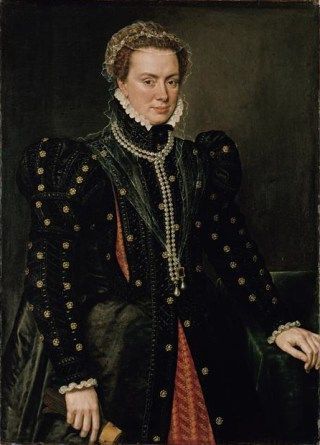
The historian points to the document that was signed by Charles in February of 1537. It refers to the matrimonial tax that should be paid by the inhabitants of Valencia, on the occasion of the wedding of his illegitimate daughter, Isabel, and Alessandro de’ Medici, that had taken place a few years earlier. It is well known that Margarita de Parma was Alessandro’s wife and after his death in 1537, she got married again, this time to Ottavio Farnese, Duke of Parma.
Orts did not establish whether Germaine was, in fact, Margarita’s mother but it seems there is no certainty that she was born in Oudenaarde as the daughter of Johanna Maria van der Gheynst. If Margarita and Isabel were the same woman, assuming that her mother was Johanna Maria, it is hard to explain why Germaine de Foix would leave her the most precious jewels that she had, speaking of her with such tenderness and love in her testament and last will. Given Margarita was brought up at the court of Margaret of Austria, being born in 1522, the Queen Dowager would not have a chance to meet her, let alone form a bond with the girl.
Some claim that the incestous relationship between Germaine and Charles did not take place because no one noted her pregnancy and the ambassadors, as well as the Emperor’s enemies, would use this against him. No one, however, has found a way to explain Germaine’s last will and the letter, in which it was clearly stated that Charles and the Queen Dowager had a daughter.
Sources:
1. Carlos V, el César y el hombre, Manuel Fernández Álvarez
2. Między wojną a dyplomacją: Ferdynand Katolicki i polityka zagraniczna Hiszpanii w latach 1492-1516, Filip Kubiaczyk
3. (x)
4. (x)
5. (x)
#perioddramaedit#historyedit#carlos rey emperador#charles v#germaine de foix#germaine of foix#germana de foix
111 notes
·
View notes
Text


Charles V acting like he wasn’t straight-up shagging his step grandmother at seventeen
#charles v#philip ii#philip ii of spain#history memes#history shitposting#tudor history#kinda anyway#emperor charles v#history#habsburg#i am so sick of charles's bs like i know he didnt have THAT many insufferable counts#((ok maybe he did. maybe he did))#but like. GERMAINE DE FOIX WHATS GOOD
37 notes
·
View notes
Photo

Disembarkation at Valencia of Ferdinand the Catholic and Germaine of Foix.
#germaine of foix#ferdinand ii#Museu de Belles Arts de València#18th century art#long live the queue
10 notes
·
View notes
Note
Why didn’t Henry VII want CoA to marry Henry? Was it grief over Arthur?
Hi, anon! So, this is a very complicated question and I promise to go back to this ask later to give more adequate evidence—I will give you a simpler answer now because I'm afraid I've been piling up too many asks in my inbox that require more elaborate answers. To speak plainly, we don't know if Henry VII didn't want to marry Catherine to Prince Henry. In my opinion, his actions do not speak of any genuine willingness on his part to follow through with the marriage. I would say it was more due to political circumstances and Henry VII's estrangement/falling out with Ferdinand of Aragon. Ferdinand notoriously refused to cooperate with Henry, and the matter goes beyond the non-payment of the dowry. Ferdinand's refusal to follow through with their previous financial agreement, his rapprochement with France at the time of his second marriage to Germaine de Foix and his pointed refusal to consent to Princess Mary and Prince Charles' betrothal all most likely soured his relationship with Henry. Catherine of Aragon represented the old alliance, Charles of Burgundy/Austria, the new.
There's a letter where Ferdinand acknowledges that Henry had told him that as much as Ferdinand wanted to see his daughter married, so did he (Henry) want to see his own daughter (Mary) married in his lifetime. There's a certain urgency to that statement: Henry by that time most likely knew he was dying, his tuberculosis had periodically worsened and abated in the previous few years. It made sense to unite his daughter to Burgundy (Charles, Philipe of Burgundy's son) who was England's traditional ally against France and to the heir of Austria, and by that same alliance acquire the backing of Spain. At some point Henry became so exasperated with Ferdinand he started conspiring against him:

We shouldn't take Henry VII at his word here, it's unclear how far he would go to deprive Ferdinand of the regency of Castile and how much of that talk was Henry simply kindling Maximilian's ambitions. The fact is, if Henry was proposing such a plan in the first plan, he must have had some degree of interest in seeing it carried out, even if not by himself. Ferdinand's friendship with France for example truly seems to have displeased Henry VII — they had started to work together towards an alliance all those years ago in 1488 to counterbalance France, after all.

The way it was said to this ambassador from Burgundy that Prince Henry was 'not much inclined to the marriage' is also very interesting to consider. Either that was true, and Henry VIII's decision to marry Catherine after his father's death arose from some sense of urgency to strengthen diplomatic relations with Spain at once (Ferdinand astutely offered Henry VIII military assistance in the case people in England opposed Henry VIII's ascension to the throne), or it was not true, yet the fact that Henry VII & his councillors wanted people to believe Prince Henry was not inclined to the marriage attests to Henry VII's own lack of inclination to follow through with the marriage.
As an aside, can I please laugh at Henry saying 'there was not a man in Paris who was such a stout Frenchman as the king of Aragon'? 😂Henry VII has a sour reputation but he had some turns of phrases that sound interesting today, and judging by the way that they were repeated verbatim by foreign ambassadors seem to suggest they were also seen as particularly ingenious/creative in his time. Another one that comes to mind is when Henry VII said he held something 'in the shrine of his heart'.
In any case, I don't think the lack of payment of Catherine's dowry was the driving force behind Henry VII's refusal to follow through with the wedding. Henry VII often used money (or lack thereof) to achieve other political means, like the time in France when he said he would only retrieve his troops from Brittany if he received financial compensation, but when the king of France offered to pay him, Henry changed his tune and said he would only receive money from the Duchess of Brittany’s own hands, highlighting her sovereignty which was not something the French were willing to do. The truth is that Henry did not want to make peace with France at that time. Similarly, Catherine of Aragon said Henry VII had told her that as long as Ferdinand did not follow through with his part (the payment of her dowry), Henry was equally free not to go through with his.
The popular narrative is that Henry VII deeply begrudged Ferdinand's refusal to pay the rest of Catherine's dowry, but he seemed to have used that to his own political advantage 🌹x
55 notes
·
View notes
Quote
The love of woman is a precious treasure. Tenderness has no deeper source, devotion no purer shrine, sacrifice no more saintlike abnegation.
Germain-Francois Poullain De Saint-Foix
12 notes
·
View notes
Text
Is this woman Isabella I of Castile or Mary Rose Tudor, Queen of France?-part 1

These two portraits are focus of very heated debate. Is this beautiful woman Queen Isabella I of Castile or Mary Rose Tudor, Queen of France(Henry VIII’s sister)? People want to know! Here is my ‘short’ take upon it.
First argument is Spanish fashion and the jewellery-which is without doubt Isabella’s. The necklace of arrows with emeralds:(tbh i don’t see arrows in it either, but it called this way)

is exactly the same one as on silver coin with Isabella I:

It was made in 1514 and might have been based upon original painting of Isabella by Sittow, but perhaps there were two of Isabella’s paintings by Sittow with this necklace. After all she loved it.
It is really similar to necklace on Juana’s tomb. I am not completely convinced it is same one though. The size of some pearls seems to be different and the front piece is missing, but it is possible Isabella had 2 necklaces of very similar style and this is the other one, or Juana wore it altered.
-detail of necklace on Juana’s tomb:

The necklace of arrows might be the same emerald necklace, Henry VII hoped Catherine of Aragon would bring as part of her dowry(he must have heard of it from his ambassadors, it was notable great piece of jewelry). But Isabella loved it too much, and didn’t want to part with it. Apparently, she wore it whenever she and Ferdinand were apart, some parts of that necklace symbolized him.
The brooch in second portrait is same as in one of Isabella’s portraits.

It only looks bit different due to different skill of artists. Sittow was great painter, the other one was good, but not on same level as Sittow.
I also strongly suspect this is non-identified portrait of Isabella:

It is part of group painting called Life St.Thomas in India,the marriage feast of the King by Alonso de Sedano and if you look at her wrist the golden bracelets are same as in one of the portraits:

(These weren’t unique jewelry of Isabella but worn by spanish noblewomen too.)
I also found that Empress Isabella of Portugal, later worn jewelry similiar to some pieces we see at those two paintings(but it is not always obvious in certain versions of her paintings(the middle on) I tilted jewelry for better idea:

Ownership of many pieces of jewellery in those potraits is undoubted fact. They belonged to crown of Castile.
Hence only women of belonging to castillian royalty could wear them. Not Germaine of Foix(because she was mere Queen of Aragon). On first glance that leaves us with just Isabella I, Juana I and Empress Isabella(she isn’t the sitter obviously).
However, for sake of future portrait identifications and not spreading misinformation, I must point out that it was common practice for women betrothed or married to start to embrace her future husband’s(or husband’s country/region) culture. Very small girls were even sent away to her fiancé’s court to learn his ways, and it could cause problems is bethrohal was cancelled. (See Margaret of Austria) If she wasn’t sent away, then they expected some proof that she started to learn the foreign ways. And portrait wearing foreign fashion would be perfect way to do it. Mary Rose Tudor wearing Spanish dress is not far fetched idea at all!
Part of reason why many believed portrait of Catherine of Aragon by Sittow is not her, was that she wasn’t wearing English fashion. Because it was unusual for the time. She was to be bethrohed to English prince yet again, so her not wearing english fashion was strange! Against custom, you could say.
But if you read biographies about her, after coming to England she and her ladies abandoned Spanish fashion (such as farthingale) and brought bits of it back only after she became Queen. But she preferred English fashion since.
Anne of Cleves’ miniature was mislabeled as Catherine Howard( despite being painted on 4 diamonds card) , because Anne wasn’t wearing fashion of her homeland in it. Instead during her short time as Queen(before annulment) she wore English style dress and jewels of Queens of England.
That was what was expected from married woman at those times! And for bethrohed girls too. Even if it was putting on a show, just when ambassadors were around or for portrait.
Hence I don’t agree with those who say Mary Rose Tudor wouldn’t have any reason to wear Spanish clothes.
Yes, she ended up being Queen of France. But before that for long time(1506-1514) she was betrothed to Charles V and she was even styled as Princess of Castile in English court.
In cca 1512-1514, painter was sent to make painting of her to be sent to her betrothed and it is said it was requested she be depicted in spanish style.
Meaning in spanish fashion.
It’s very different narrative than we have about these things nowadays. But at the time, this would be most probable scenario about that painting and its dress. It’d be as Spanish as possible! Headwear too.
The issue, isn’t spanish jewelry by itself either. It would be expected to be worn too. We don’t know what Spanish jewellery Mary Rise got depicted with. Might have been some Queen Catherine lent to her. But it could have been the case that some jewels were sent to England especially for purpose of painting portrait of future princess of Castile and returned to Spain after betrothal got cancelled.
Or sent to her as bride in advance, that was done sometimes.
The ISSUE is such huge, unique and expensive jewelry being sent across sea.
Because if ship sank, you’d loose it. I think the jewelry is up for debate- It’d be great gesture if it got to England, and would sway English King in Spain’s favor-if it was sent. On other hand there would be reasons not to sent it. Reasons exist for both.
Hence Mary Rose in Spanish clothes-yes that would happen! In necklace of arrows prior to marriage? Unlikely, but not impossible.
Second argument is woman’s hair colour. Yet most people don’t know what hair colour either of those women had! And spread misinformation.
Take Mary Rose Tudor’s locks of hair( 3 of them, all supposedly taken from her remains) and supposed notion she was blond. On certain websites I’ve seen entire lenghtly descriptions of her(quotes from people who met her)-but with one detail changed: her hair described as blond. I don’t find it funny.

I’ve looked up supposed blond lock. It’s strawberry blond! And just to remind you another Mary Tudor(Mary I) was strawberry blond without doubt, so I strongly suspect it was contributed to wrong Mary Tudor. But even if it was real it wouldn’t exclude Mary Rose Tudor from this ‘competition’. My hair is dark brown around roots yet very light brown at ends. Hers could do the same.
Another problem is most people didn’t even hear of darkening of pigments or about changing nature of strawberry blond hair let alone dark golden strawberry blond hair(which Isabella had) and how it can seem golden to one person and to other red etc. Millions of people think Isabella was brunette! And hence argue it must have been Mary Rose! Ignoring that in marriage portrait of Mary Rose, she too has dark brown hair! Because her portrait also darkened!
Other people think Isabella must have had auburn hair, because Wikipedia said so! (Until somebody has changed it and also explained why Isabella’s portraits show brunette :)
I’ve looked at originals. Magdalene in The National Gallery in London:
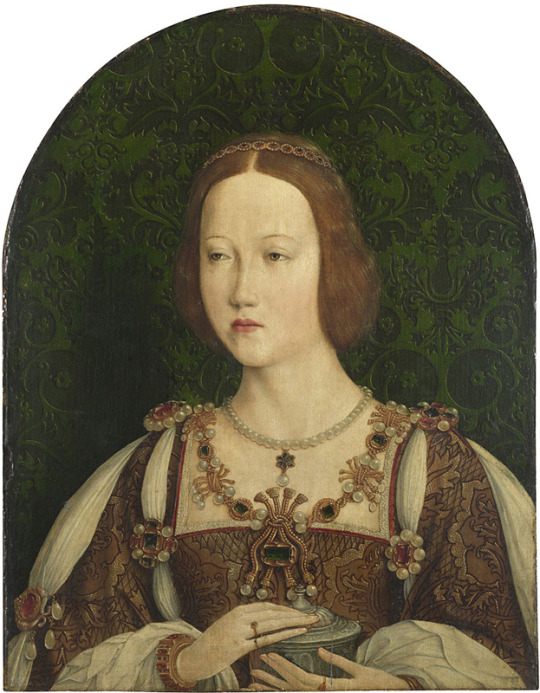
and Portrait de Marie d'Angleterre in Musée des Arts Décoratifs in Paris:

Neither of those portraits shows as vivid red hair as the versions circulating online and we cannot tell, if sitter had red hair or dark strawberry blond. We simply can’t! It could be either! Hence both women are in!
Third point is background. Green background in paintings was already in England around 1500, but wasn’t in Spain(and spread to court of Emperor Maximilian only in late 1500s). However illumination of Isabella with Juana(or possibly Isabella, Queen of Portugal after she became heir) show green background.

So, Isabella might have chosen green background too and it doesn’t prove it is Mary Rose Tudor!
4th-the Red kirtle/petticoat:

Popular in England, but Spanish wore them too:

Next is (religious) symbolism:
Paris’ portrait:

On first glance you’d think the figure is holding jar of ointment(attribute of Mary Magdalene) and that it depicts woman as Mary Magdalene. But if you look at hands closely, it is clear originally they didn’t hold the jar(on left how it might have looked like). The jar was painted into painting afterwards.
Hence this is not a religious painting.
(Sitter was holding one of her rings, idk symbolism behind such gesture. But it doesn’t symbolize betrothal, because I later found some married characters who also held their rings in this way, but more about that later on.)
Magdalene portrait:

On first glance this one seems like it is correctly labeled as Magdalene.
I explained that Catherine of Aragon as Mary Magdalene by Sittow, symbolized she was truthful and of good character, and that her arrival might even symbolize good things to come.
Such meaning could work with both Isabella(as ruler, that is good symbolic meaning) or with Mary Rose(as bride, it is good meaning also).
But:London’s Nationally gallery points out that originally woman held a gilded book and not a jar. (and one hand rested on top of book). And some of book’s ends are still visible(I recomend going to their webpage which has it HD). The book must have been fully painted for it to be gilded.

So that was the original prop. Yes, Isabella was painted with prayer book many times. But so were the countless other women at the time. It just proves the sitter wanted to show their piety.
There is also tulip as patern in Magdalena’s dress. New study now says tulip was in Spain since 11th century, hence it was there in Isabella’s lifetime. I looked at the symbolism, and it has nothing to do with Ottomans, with protestants etc.
So my conclusion it is simply flower that grew in Spain. Both women had reason to wear spanish clothes, hence spanish clothes with spanish flower also.
Fabric in Magdalene’s portrait is also cloth of gold and silver(or cloth of gold with silver embroidery) with crimson details. One of Isabella’s potraits shows very similiar fabric, but unfortunately golden colour in dress darkened to brown.
While seemingly it could point to Isabella, such fabric would be available to Mary Rose too(being royal) and would be way more likely to be sent to her than unique necklace of arrows.
Another argument are the eyes. In portraits they look grey. Mary Rose Tudor was described as having pale grey eyes. Isabella’s as having blue.
But often painters used ultramarine blue for just mere detail of eyes(it wouldn’t fade), instead they used cheaper pigments, which faded over time.
Hence original blue eyes often in paintings end up as grey-Mary I is fine example of that. Mary Rose Tudor having supposedly grey eyes, raised big mystery for me. I’ve seen potrait of her father, detail of his eyes and they were blue. Her mum’s was supposedly blue-eyed too. I am not saying it is genetically impossible. (I know person who has AB+ blood and her biological mum is 0+, she wasn’t switched as baby.)
But there is lots of misinformation even among credible historians, who still describe her as blond-instead of strawberry blond. Some sources say grey eyes, and it is actually possible she had blue-grey eyes and her daughter too(if they were really that pale than it’d be really hard to tell if they were pale grey or pale blue or both).
Pink ribbons and auger shells in Paris portrait also got us nowehere.

Augers live in both countries! And while pink carnation was asociated with bethrohal, mere ribbon isn’t. Plus Isabella wore either pink or purple even as married woman:

Hence all previous points would work for both women, and don’t exclude anybody.
With this in mind we have to judge these portraits on other details such as features of sitter(to see if we can exclude one or both women) and fashion(dress and headwear) to see when the portrait was made.
Isabella died in 1504, I really doubt she’d have portrait done in her last dying months, Mary Rose Tudor would have been sitting for portrait cca 1513/1514.
Especially because sitter in both paintings is young. It is assumed it could be young Isabella aged 30(because there was portrait of her by Master Michel(Sittow) aged 30). Isabella in cca 1481 vs Mary Rose Tudor cca 1513, it shouldn’t be hard to determine! But of course now I’ve said it, I’ve jinxed it.
Because what I found out next made me question everything.
I did post about Isabella’s depictions and while going through various museums and art galleries’ webpages I realised, what should have been obvious to me from the start.
The fashion in two potraits we’re trying to identify is not 15th century fashion.
It’s 1505-1520. That is my opinion and you’re welcomed to try to challenge/disprove it.
Allow me to explain:

Isabella last wore her hair up in 1470s and 1480s, but then never again(she wore it hanging low in 1490s.)

But headwear(cofia) is not at all from her early days, but style exactly between late 1490s and 1525. It is different enough for me to suggest at least 5 years passed between last known potrait of Isabella and this one.
And dress support it. Even if I was totally off with my dates of Isabella’s paintings, in none she wears such fashion! Nobody is in 15th century!
Closest to it is Juana’s dress in The Virgin of Mercy with the Family of the Catholic Monarchs, but at same time cofia of her sister Isabela(Queen of Portugal) disproves that this could be from same time as our two potraits. It is way too different- the rounded neckline and sleeves from two parts etc.

Look at our unidentified potraits yet again. Hat pinched on side, how large the slashes are on one of them, the net parlet, the auger shells(which reminds you of those decorative pieces used in late 1530s and in 1540s). It’s too many details which scream 16th century.

Isabella didn’t wear net parlets, they very became popular in Portugal and France later on, but they were worn in Spain too. Which French woman in Spain wore net partlet?
Germaine of Foix:

We don’t know when her potrait was done, but it is her as married woman hence 1505+, and no later than 1516. Hers is decorated with pearls, but they didn’t need to be. Also note where her hair is, how high up.Aproximately same height as in our two potraits. The slashes on Germaine’s dress (though differently placed) are also rather long(as in one of potraits) This ties it stronger to timeframme 1505-1525.
If that wasn’t prove enough.
I also compared features in bit more detail and figured distances in portraits don’t match. Especially the forehead and neck of Isabella are too short.

If eyes, nose and chin all are same distance, why isn’t forehead and neck then matching in distance also? It is almost exact same angle both women sit at and both these portraits are extremely realistic. You cannot have better ones for comparison. Yet the distances aren’t match and in all but one of Isabella’s known potraits she has really short forehead and short neck! Thick but short.
Sorry folks, but is not her! At least not true contemporary unaltered potrait of her.
Posthumous altered portrait is possible I guess, but i doubt it.
I thought, alright so let’s move to Mary Rose Tudor then. But then I’ve looked at this portrait of Juana with rather high forehead

and realised, it still can be Queen of Castile, just different one.
So part two will be Juana I of Castille vs Mary Rose Tudor.
10 notes
·
View notes
Note
Ship bingo: Felipe II & Ana, Princess of Eboli / Carlos V & Queen Germaine de Foix / Elizabeth I & Robert, Earl of Essex
Felipe II & Ana, Princess of Eboli

Carlos V & Queen Germaine de Foix

Elizabeth I & Robert, Earl of Essex

I don't ship Elizabeth and Essex but I think their relationship can be described as platonic.
Thank you for asking!
1 note
·
View note
Photo


Victims of the Childbed - Anne of Foix-Candale, Queen of Bohemia and Hungary & Anna Jagellonica, Queen of Hungary and Bohemia, Germany, and the Romans
A mother and daughter who led quiet lives as royal consorts but shaped the future of Hungary and then the Holy Roman Empire.
Anne belonged to a cadet branch of the noble French family of Foix. She was a child when her mother, Infanta Catherine of Navarre, died. Her father, Gaston de Foix, Count of Candale (or Earl of Kendal as he was styled in England) came from a line of soldiers who had fought in service of the English crown. When Anne was around seven, Gaston sent her to be fostered at the court of Anne of Brittany and Louis XII of France. This was a common practice among nobles, particularly in the medieval era. Under Queen Anne’s instruction, Anne de Foix was expected to become a learned and accomplished lady, and hopefully make an advantageous marriage.
By early 1500, Anne had been orphaned. The Queen took responsibility for her protege’s marriage. It just so happened that Anne of Brittany had a knack for matchmaking, so when the recently divorced King Vladislaus II of Hungary sent envoys to France in search of a suitable wife, she seized her chance. Two portraits were sent to Hungary, on of Anne of Foix-Candale and one of her cousin Germaine de Foix. Anne’s portrait was found to be the most agreeable to Vladislaus and they were soon betrothed.
In May 1502, eighteen-year-old Anne left France with a queen’s escort. She traveled for 4 months and was fêted in several cities before arriving in Buda in September, where she was greeted by King Vladislaus. They were married on September 29. Anne was naturally homesick in the early days of her marriage, but she soon made a new home as Queen of Hungary. She and Vladislaus got along well and grew to be friends, with her acting as his personal advisor. Yet at forty-six and despite two previous marriages, Vladislaus had no surviving children. He did not have to wait long, for less than a year after their wedding Anne gave birth to their first child, a daughter who would be known as Anna Jagellonica, in July 1503.
Anne’s popularity in her new country grew over the next few years. Her popularity and influence would have reached its zenith on July 1, 1506 when she gave birth to a son, Louis, born prematurely but alive. But Anne contracted puerperal fever and died on July 26 after fighting the infection for three weeks. The baby boy was said to have been incubated in the bodies of newly slaughtered pigs, but he survived the first uncertain weeks of life.
Anna Jagellonica and Louis grew up without knowing their mother. They were then orphaned in 1516 when King Vladislaus died. The children came under the protection of Holy Roman Emperor Maximilian. From this point, Anna and Louis would have very different upbringings, as the ten-year-old boy was now King of Hungary. Anna was intelligent and well educated. She would learn to speak Latin, German, and Czech in addition to her native Hungarian.
Emperor Maximilian arranged Anna’s marriage to his grandson Ferdinand, son of Juana of Castile and the late Phillip of Hapsburg. Anna and Ferdinand were married on May 26, 1521 and were both in their eighteenth year. From this point onward, Anna would seldom be separated from her husband. One stipulation of the union was that Ferdinand would succeed Louis if the young king were to die without an heir. This event must have seemed unlikely until five years later was killed fighting against Sultan Suleiman the Magnificent at the Battle of Mohaćs. He was only twenty and had not fathered any legitimate children.
Ferdinand quickly laid claims to Bohemia and Hungary. He was soon elected King of Bohemia, but the situation in Hungary was complicated by the Ottoman presence. There were also rival claimants to the throne, but Ferdinand’s claim was certainly strengthened by Anna’s.
Anna was a model of the traditional queen consort. She was pious and devoted her time to good works, religion, and her children, which began arriving with alarming quickness. Since Anna was always by her husband’s side, the royal nursery was kept well stocked. Their first child, Elisabeth, was born in 1526, followed a year later by the future Emperor Maximilian II. After her firstborn’s birth, Anna would give birth on an almost yearly basis. From 1526 to 1547 she would bear an astonishing fifteen children. On January 24, 1547, Anna gave birth to her last child and eleventh daughter, Joanna. She died three days later, possibly from puerperal fever like her own mother, or simply from the physical toll so many pregnancies had taken on her body. Anna was interred at St. Vitus Cathedral in Prague. Ferdinand never remarried and became Holy Roman Emperor nine years later.
Sources: Pauline Matarasso, Queen’s Mate: Three women of power in France on the eve of the Renaissance
Martyn Rady, Customary Law in Hungary: Courts, Texts, and the Tripartitum
#childbirth cw#death cw#this sure was...something#Anne of Foix-Candale#Anna Jagellonica#Anne of Hungary and Bohemia#I just chose to call her by her popular name bc it's easier to differentiate#since she was probably named for her mother#holy roman empire#victims of the childbed#art#my art
98 notes
·
View notes
Photo







Aragonese infantas aesthetic, part III
Zuria II.a Nafarroakoa. Daughter of Joan II and Zuria I.a Nafarroakoa.
Leonor I.a Nafarroakoa. Daughter of Joan II and Zuria I.a Nafarroakoa. Mother of Marguerite de Foix, duchesse de Bretagne; Jehanne de Foix, comtesse d’Armagnac; Catherine de Foix, comtesse de Candale; and Isabelle de Foix, vicomtesse de Turenne. Grandmother of Catherine Ire de Navarre; Germaine de Foix, reina d’Aragó; Anna Breizh, reine de France; and Anne de Foix-Candale, Magyar királyné.
Joana, regina di Napoli. Daughter of Joan II and Juana Enriquez de Córdoba. Mother of Juana de Trastámara, regina di Napoli.
Isabel, rainha de Portugal. Daughter of Fernando II and Isabel I de Castilla.
Juana I, reina de Castilla. Daughter of Fernando II and Isabel I de Castilla. Mother of Leonor de Austria, rainha de Portugal; Isabel de Austria, Dronning af Danmark; María de Austria, Magyar királyné; and Catalina de Austria, rainha de Portugal.
María, rainha de Portugal. Daughter of Fernando II and Isabel I de Castilla. Mother of Isabel de Portugal, Sacri Romani Imperatrix and Beatriz de Portugal, duchessa di Savoia.
Catalina, Queen of England. Daughter of Fernando II and Isabel I de Castilla. Mother of Mary I of England.
#house of trastamara#historyedit#spanish history#european history#women's history#history#nanshe's graphics#royalty aesthetic
104 notes
·
View notes